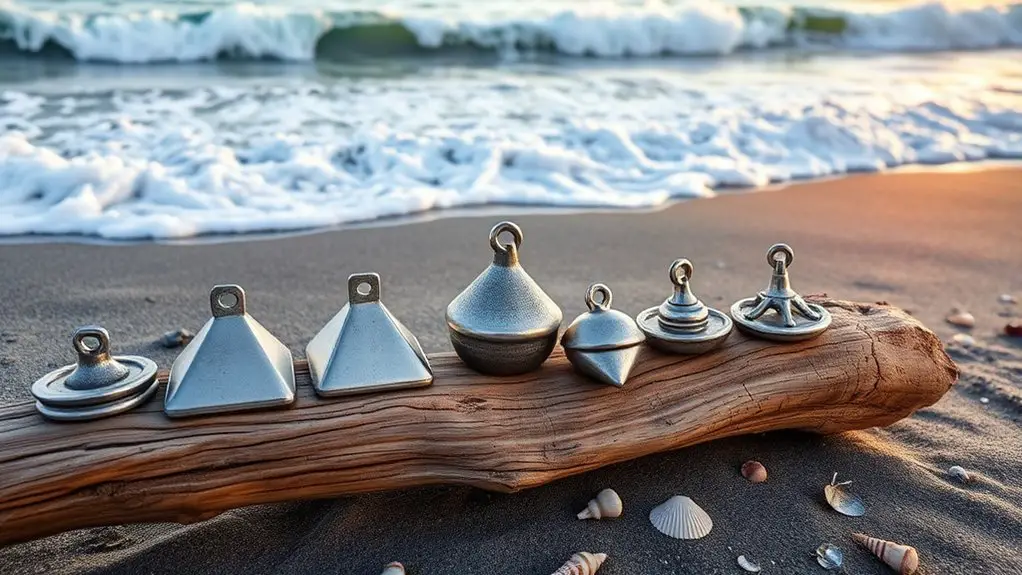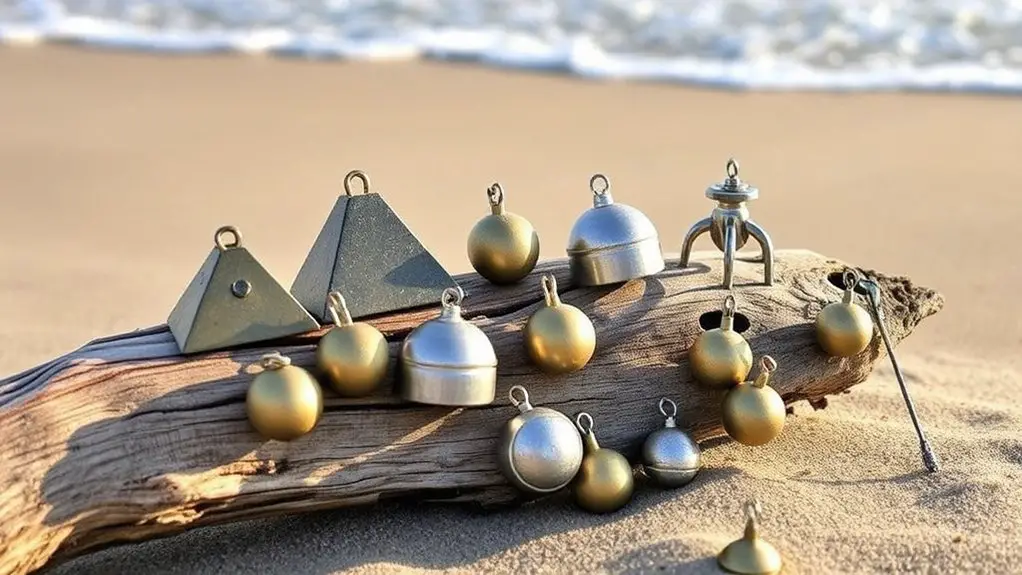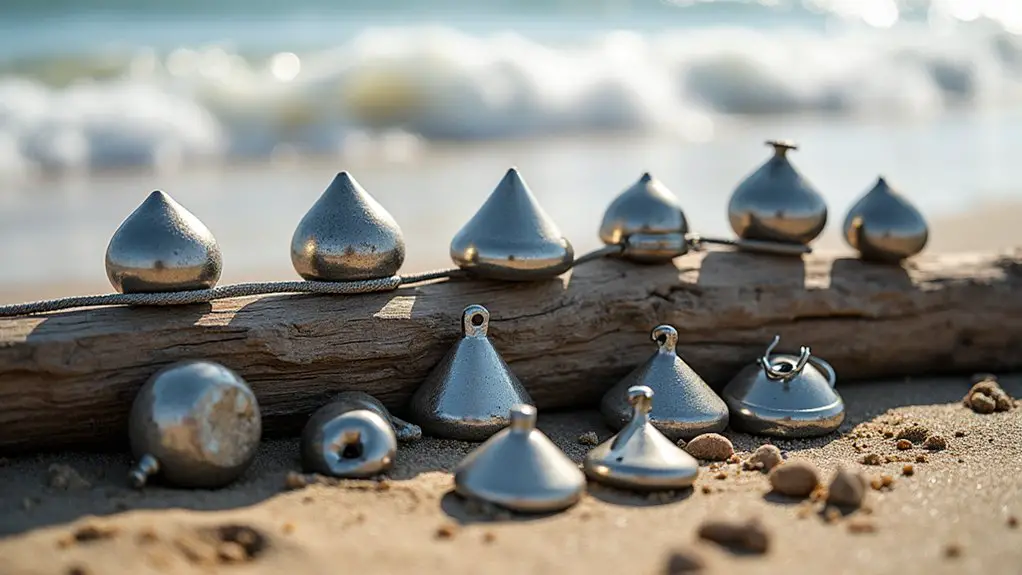For successful surf fishing, you’ll need to match your sinker to the conditions. Pyramid sinkers (1.5-8oz) work best on sandy bottoms in light to moderate surf, while sputnik sinkers with wire arms provide superior holding power in rough waters. Egg sinkers allow natural bait movement in mild conditions, and bank sinkers offer streamlined casting distance. Consider your local beach conditions, tides, and seasonal changes when selecting weights. The right sinker can dramatically improve your catch rate on your next coastal adventure.
Surf Fishing Highlights
- Pyramid sinkers (1.5-8 oz) provide excellent holding power in sandy bottoms while offering good casting distance for moderate surf conditions.
- Sputnik sinkers with retractable wire arms deliver maximum grip in rough seas, making them essential for strong currents and outgoing tides.
- Match sinker weight to water conditions: light currents (1/4-1 oz), moderate surf (2-3 oz), and rough seas (4+ oz).
- Egg sinkers allow natural bait movement in mild surf conditions and bounce off rocks rather than snagging.
- Heavier weights are required during winter (3-6 oz) and outgoing tides, while summer conditions permit lighter options (1-3 oz).
Understanding the Basics of Surf Fishing Weights
Every successful surf fishing expedition begins with selecting the right weight for your specific conditions.
When you’re battling waves and currents, your sinker’s shape and weight become critical tools in your arsenal.
Pyramid sinkers dig into sandy bottoms, preventing unwanted movement, while sputnik weights (with their wire arms) offer superior holding power when surf gets rough.
You’ll find egg sinkers perfect for allowing natural bait movement, especially in Carolina rigs.
Meanwhile, split shots deliver sensitivity for finesse presentations.
For most surf fishing situations, you’ll need weights ranging from one to four ounces![]() depending on the strength of the water current and your desired casting distance.
depending on the strength of the water current and your desired casting distance.
Bank sinkers provide versatile options![]() for various surf fishing setups and can be easily attached to sinker slides for quick weight adjustments.
for various surf fishing setups and can be easily attached to sinker slides for quick weight adjustments.
Improper sinker selection is a common mistake![]() among anglers that can drastically reduce your catch rate by allowing bait to wash away in surf conditions.
among anglers that can drastically reduce your catch rate by allowing bait to wash away in surf conditions.
Pyramid Sinkers: The Versatile Staple for Sandy Bottoms
Surf anglers worldwide consider pyramid sinkers the unsung heroes of their tackle boxes, and for good reason. Their triangular, multi-sided design digs firmly into sandy or muddy bottoms, keeping your bait precisely where fish are feeding.
You’ll find these lead weights in sizes from 1.5 to 8 oz, perfect for light to moderate surf conditions. Unlike round sinkers that roll with the current, pyramid sinkers anchor down with their pointy tips and flat edges.
They’re your best bet for sandy beaches, offering that sweet spot between casting distance and holding power—though they’ll struggle on rocky bottoms or in heavy surf. The streamlined design![]() of pyramid sinkers significantly reduces the chances of snagging during your cast, allowing for smoother fishing sessions. Their aerodynamic shape
of pyramid sinkers significantly reduces the chances of snagging during your cast, allowing for smoother fishing sessions. Their aerodynamic shape![]() enables anglers to achieve impressive long-distance casting when targeting fish beyond the breakers. Available in both 3 sided and 4 sided
enables anglers to achieve impressive long-distance casting when targeting fish beyond the breakers. Available in both 3 sided and 4 sided![]() versions, these versatile weights are effective for everything from catching small perch to landing sharks.
versions, these versatile weights are effective for everything from catching small perch to landing sharks.
Sputnik Sinkers: Maximum Holding Power in Rough Conditions
When extreme conditions threaten to drag your rig away, sputnik sinkers emerge as the undisputed champions of the surf fishing world. With their retractable stainless steel wire arms that dig deep into sandy bottoms, you’ll maintain perfect bait positioning even in the roughest surf. These specialized weights are excellent for developing an effective scent trail![]() as your bait remains in position longer. Made from corrosion-resistant materials
as your bait remains in position longer. Made from corrosion-resistant materials![]() , sputnik sinkers ensure long-lasting performance even in harsh saltwater environments. The superior leg and locking system
, sputnik sinkers ensure long-lasting performance even in harsh saltwater environments. The superior leg and locking system![]() makes these sinkers more reliable than traditional tackle shop options.
makes these sinkers more reliable than traditional tackle shop options.
| Weight | Best For | Holding Power |
|---|---|---|
| 2-3 oz | Light surf, smaller species | Replaces 4-5 oz pyramids |
| 4-5 oz | Medium surf, standard fishing | Ideal for chunking techniques |
| 6-7 oz | Heavy surf, large predators | Stays put when others fail |
| 8+ oz | Extreme conditions, shark fishing | Maximum stability in any water |
You’ll appreciate their aerodynamic design for longer casts and superior holding power—a 3 oz sputnik often outperforms a 5 oz pyramid!
Egg Sinkers: When Natural Bait Movement Matters

For anglers seeking the most natural bait presentation possible, egg sinkers offer unmatched versatility in the surf fishing arsenal. Their oval shape with a central hole allows your line to slide freely, creating that realistic drift that mimics live prey.
You’ll find they excel in mild surf conditions (think Southern California’s gentle 1-3 ft waves), where ½-¾ oz weights balance casting distance with subtle action.
They’re Carolina rig superstars, keeping your bait moving independently from the weight. Adding a bead between the sinker and swivel creates a clicking sound![]() that attracts drum and sea trout to your presentation. Unlike their grabby cousins, egg sinkers bounce off rocks rather than snagging, letting your sand crabs, worms, or soft plastics dance enticingly along the bottom.
that attracts drum and sea trout to your presentation. Unlike their grabby cousins, egg sinkers bounce off rocks rather than snagging, letting your sand crabs, worms, or soft plastics dance enticingly along the bottom.
Bank Sinkers: Streamlined Design for Distance Casting
While egg sinkers shine in gentle conditions, sometimes you need something built specifically for distance.
Bank sinkers, with their cylindrical shape and flat side, cut through water with minimal resistance—perfect for when you’re trying to reach those far-off feeding zones.
You’ll appreciate how these streamlined weights hold steady in currents while their rounded edges prevent frustrating snags.
They’re available in weights from ½ to 6 oz, letting you match your tackle to conditions.
For strong surf, remember this rule of thumb: a 3 oz sinker pairs well with 30 lb braid for ideal casting control.
These sinkers are particularly effective in still or slow-moving![]() waters where their design maximizes both distance and stability.
waters where their design maximizes both distance and stability.
Bank sinkers are especially valuable in ocean and riverbank![]() fishing environments where their ability to maintain bait positioning is crucial.
fishing environments where their ability to maintain bait positioning is crucial.
Split Shot and Specialty Weights: Finesse Options for Calm Surf
Why rely on bulky weights when gentle surf calls for a lighter touch?
Split shots—those tiny, grooved pellets you can pinch onto your line—offer remarkable versatility when the water’s calm. You’ll appreciate their quick-adjustment capability without re-tying, perfect for keeping bait in the strike zone.
For even more finesse, try rubber-core sinkers or oval-shaped clam shots that reduce snags while maintaining sensitivity. These smaller weights are particularly effective as they’re snag-resistant designs![]() that help you navigate rocky or weedy surf conditions. Following the principle that natural presentation
that help you navigate rocky or weedy surf conditions. Following the principle that natural presentation![]() increases success rates across all fishing disciplines, these lighter weights allow your bait to move more realistically. Drop shot and egg sinkers complement your light-tackle arsenal beautifully.
increases success rates across all fishing disciplines, these lighter weights allow your bait to move more realistically. Drop shot and egg sinkers complement your light-tackle arsenal beautifully.
Remember to use the lightest effective weight and space multiple split shots along your line to fine-tune your presentation. Your subtle approach might just fool those wary fish that heavy weights would send swimming!
Matching Sinker Weight to Surf Conditions and Swell Height

Three key factors determine your sinker weight selection: current strength, swell height, and casting distance requirements.
Light currents call for weights between 1/32 to 1/4 oz, while angry seas might demand a hefty 4 oz anchor!
Match your weight to water conditions—whisper-light for gentle currents, heavyweight champions when the ocean rages.
When waves grow, so should your sinker weight. Those pyramid and sputnik designs aren’t just pretty shapes—they’re engineered to grip sandy bottoms when the ocean throws a tantrum.
Most anglers find 1-4 oz handles typical conditions, but always pack options. Pyramid sinkers are particularly effective because their inverted pyramid shape![]() prevents rolling while maintaining bait position in strong currents. In stronger tides, you’ll need grapnel sinkers
prevents rolling while maintaining bait position in strong currents. In stronger tides, you’ll need grapnel sinkers![]() with their wire legs for superior bottom holding.
with their wire legs for superior bottom holding.
How Tides and Current Affect Your Weight Selection
Surf fishing success relies heavily on understanding tidal patterns, which change everything about your weight selection strategy.
When that outgoing tide starts pulling hard, you’ll need heavier sinkers (often 4-6oz) to keep your rig anchored rather than dragged shoreward.
During slack tide, you can lighten up considerably—your 2-3oz weights will hold just fine when current forces diminish.
Remember, pyramid sinkers dig into sandy bottoms while those spiky sputniks are your best friends in strong currents.
Always match your sinker to the flow: use just enough weight to hold position without sacrificing sensitivity or casting distance.
Disc sinkers![]() work exceptionally well in calmer conditions where stability rather than deep anchoring is the priority.
work exceptionally well in calmer conditions where stability rather than deep anchoring is the priority.
Optimal Sinkers for Different Surf Fishing Rigs
Choosing the right sinker transforms your surf fishing setup from mediocre to magnificent, directly impacting how well your bait sits in the strike zone.
For standard double drop bottom rigs, pyramid sinkers are your go-to workhorses—they dig into sand efficiently when the surf’s behaving (1-2 ft swells). When those waves turn angry, swap to sputnik sinkers; their wire legs grip the seafloor like a stubborn barnacle!
For Carolina rigs, egg sinkers slide beautifully, giving your bait natural movement. The highly mobile design![]() allows live bait to move freely, increasing your chances of enticing strikes from passing fish.
allows live bait to move freely, increasing your chances of enticing strikes from passing fish.
Storm sinkers offer middle-ground performance with their re-digging capabilities, while bank sinkers reduce drag for those monster casts you’ve been dreaming about.
Regional Considerations: Adapting to Your Local Beach

While mastering surf fishing fundamentals remains universal, your specific stretch of coastline demands customized weight strategies that respect its unique personality.
Southern California’s sandy bottoms call for 2-3 ounce pyramid sinkers that anchor firmly during moderate tides, while Baja’s stronger currents might require 4-ounce models.
You’ll need heavier weights during windy days (mother nature’s little challenge!) or when targeting bottom-dwellers like halibut. When facing strong headwinds of 15-18 mph![]() , consider upgrading from your 2-ounce sinker to prevent casting difficulties.
, consider upgrading from your 2-ounce sinker to prevent casting difficulties.
Rocky coastlines? Skip the pyramids and opt for egg sinkers that won’t lodge between boulders.
Remember, local regulations might restrict lead weights in some eco-sensitive areas, so pack tungsten alternatives.
Your perfect sinker balances current strength, bottom composition, and target species.
Weight Material Matters: Lead Alternatives and Environmental Impacts
For decades, traditional lead sinkers have dominated tackle boxes despite their significant environmental footprint. When lost in water, they poison aquatic life and birds, contaminating entire ecosystems.
Fortunately, you’ve got options! Tungsten sinkers offer higher density in smaller packages (though at a higher price tag).
Steel provides an eco-friendly alternative that won’t break the bank, albeit with more drag. Bismuth and tin alloys strike a middle ground.
Your choice matters—many regions now restrict or ban lead tackle altogether. By selecting non-toxic alternatives, you’re not just following regulations; you’re helping preserve the beaches and waterways you love to fish.
Seasonal Adjustments to Your Sinker Strategy
Beyond the material your weight is made from, the changing seasons greatly impact which sinkers you’ll need in your tackle box.
Winter’s angry surf demands heavier pyramid sinkers (3-6 oz) to anchor your bait against strong currents, while summer’s gentler waters let you downsize to 1-3 oz eggs or torpedoes for a more natural presentation.
Season dictates weight—heavy pyramids for winter’s fury, light eggs for summer’s calm.
Fall requires a middle-ground approach with moderate weights that balance stability and movement.
Your sinker strategy should also adjust to seasonal species—redfish in winter need bottom-hugging pyramids, while summer surfperch respond better to lighter egg sinkers. Consider using the Carolina-style rig with ¾- to 1.5-ounce![]() egg sinkers for ideal surfperch fishing setups.
egg sinkers for ideal surfperch fishing setups.
Remember: the right seasonal weight keeps your bait where the fish are biting!
Advanced Techniques: Using Multiple Weight Configurations

As your surf fishing skills evolve, experimenting with multiple weight configurations can dramatically improve your success rate. By incorporating dropper loops with varied sinker sizes (0.5-5 oz), you’ll maintain better bait stability even in challenging currents.
Try positioning heavier weights at the bottom of your rig to anchor it, while adding lighter weights above to perfect your presentation. Sputnik sinkers work wonders when mixed with conventional weights—they grip the seafloor like tiny anchors!
For ultimate flexibility, add clip-on split shots that you can adjust mid-session without retying. This strategic approach lets you target multiple species simultaneously while adapting quickly to changing surf conditions.
Frequently Asked Questions
Can I Reuse Sinkers That Show Signs of Wear?
You can reuse sinkers with minor surface wear like small scratches or discoloration.
However, toss any with cracks, deep scratches, or bent attachment points—these flaws are fishing heartbreakers!
Check for corrosion too, especially on lead sinkers that’ve braved saltwater battles.
Your fishing success depends on structural integrity, so inspect after each use.
For environmental brownie points, consider switching to non-toxic alternatives like tungsten or steel.
How Do Weight Shapes Affect Distance in Different Wind Conditions?
In strong winds, your sinker shape makes all the difference!
Streamlined designs like tongue and torpedo sinkers slice through headwinds, giving you those extra yards when casting.
Crosswinds? You’ll want heavier, more aerodynamic shapes to minimize drift.
When the wind’s at your back (lucky you!), even less aerodynamic pyramids will sail impressively far.
Are Tungsten Weights Worth the Higher Price for Surf Fishing?
Tungsten’s typically not worth the premium for surf fishing.
While its density and sensitivity shine in freshwater applications, these advantages diminish in the churning surf. You’ll barely notice the enhanced feel when waves are crashing!
Your money’s better spent on quality pyramid or storm sinkers made of lead or steel.
Since you’re constantly battling surf forces (and occasionally losing gear), the cost-to-benefit ratio simply doesn’t add up when you’re chucking weights into the breakers.
How Often Should I Replace Wire Arms on Sputnik Sinkers?
Did you know that 73% of surf anglers replace wire arms too late, after performance has already declined?
You should inspect your sputnik sinker arms after every 5-10 fishing sessions, depending on surf conditions. Replace them immediately if you notice any bending, breaking, or poor sand penetration. Heavy surf fishing might require more frequent replacements.
Keep your sinkers “armed and dangerous” (pun intended!) by tightening loose wires between uses and storing them properly to extend their lifespan.
Can Certain Sinker Types Spook Fish in Clear Water Conditions?
Yes, certain sinker types can definitely spook fish in clear water! Shiny, metallic sinkers create flash that screams “something’s wrong!” to wary fish.
You’ll want to choose matte, dark-colored, or camouflaged sinkers that blend with the bottom. Tungsten weights, being smaller and denser, create less disturbance than bulkier options.
Also, consider sinkers that minimize movement once settled—pyramid and sputnik styles anchor firmly without the fish-scaring drag that round sinkers can cause.
Smart choice makes all the difference!
Conclusion
Choosing the right surf fishing weight can make the difference between coming home empty-handed or with a cooler so full you’ll need a forklift to move it! You’ve now got all the tools to match sinkers to conditions, whether you’re facing hurricane-force surf or calm waters. Remember, the perfect weight balances holding power, casting distance, and environmental responsibility. Adapt your strategy seasonally, and you’ll dramatically improve your success rate on any shoreline.

